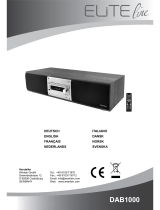
4 • KB 42
Safety Notes
Caution icons
You will fi nd the following caution icons in this user man-
ual:
Danger High risk!
Failure to heed the warning may result in injury
for life and limb.
Attention
Moderate risk!
Failure to heed the warning may result in dam-
age to property.
Low risk!
Points which should be observed when handling
the unit.
Safety Notes
Danger Danger of electric shock!
Faulty installation of electrical equipment or
mains voltage which is too high can cause elec-
tric shocks.
• The device is suitable for connection to a mains voltage
of 220 V–240 V ~ / 50 Hz only.
• If the case or mains cable is defective or shows other
signs of visible damage, disconnect the power plug
immediately and do not operate the device.
• If the device emits smoke, smells burnt or produces
unusual sounds, immediately disconnect it from the
mains and do not operate it further.
• The standby button does not disconnect the device
from the power supply. For this reason, connect it to an
easily accessible socket so that you can quickly discon-
nect it from the mains in the event of faults.
• Never open the device housing.
Repairs may only be carried out by an authorised
specialist workshop. Only parts that match the original
specifi cations may be used. There are electrical and
mechanical parts in this device which are necessary in
order to avoid exposure to sources of danger.
• Do not insert any objects through the vents in the
housing.
• Only use the device indoors.
• Do not operate the device in wet rooms and protect it
from dripping and splashing water.
Make sure that no vases or other liquid-fi lled objects
are located on or near the device in order to prevent
liquid from penetrating the housing. If water or other
debris penetrate the unit, immediately disconnect the
power plug and, if necessary, remove any batteries. Then
send the device to our service address.
• Never touch the mains plug with wet hands.
• Check the device regularly for damage.
Danger Danger to children!
Children can become trapped in the plastic
wrapping when playing and suffocate.
• Do not allow children to play with the device or the plas-
tic wrapping. There is a danger of suffocation.
• Ensure that children do not remove small parts from the
device or take them off of the device (e.g. The batteries
from the remote control, control knobs or plug adapt-
ers). They could swallow the parts and choke.
If, however, a battery is swallowed, immediately consult
a physician together with your child.
• Never allow children to operate electrical equipment
unsupervised.
Danger Danger to hearing!
Listening at high volumes may lead to hearing
loss.
Particularly when an active subwoofer has been set to
maximum volume and the unit is activated, very high
noise pressure may suddenly be produced. This may have
psychological consequences and also cause physical
injury. Children and pets are particularly at risk.
• Set your signal source device volume control to a low
setting.
• When the volume is set high, always keep a certain dis-
tance from the device and never place your ear directly
on the speaker.
• To avoid damage to health, avoid extended listening at
high volumes.
Danger Danger of chemical burns!
Leaking battery acid may lead to chemical
burns.
• Do not allow battery acid to come into contact with skin,
eyes or mucous membranes. In the event of contact
with acid, immediately fl ush the applicable areas with
plenty of clean water and consult a physician if neces-
sary.
Danger Danger of explosion!
Lithium batteries can explode if handled im-
properly.
• Never attempt to recharge lithium batteries.
• Only use batteries of the same or equivalent type.
• Never heat or short circuit batteries or rechargeable
batteries, or dispose of them in fi re.
Do not expose batteries and rechargeable batteries to
direct sunlight.





















